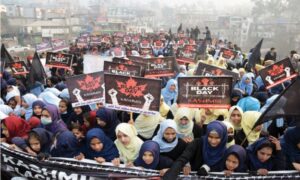
Kashmiris are not just losing property, they are being written out of their own story, writes Mian Zikria.
Every year on August 5, Youm-e-Istehsal is observed to mark the beginning of a systematic campaign to strip Jammu and Kashmir of its land, rights, and identity following the abrogation of Article 370 in 2019.
The revocation of Kashmir’s limited autonomy by the Indian government was not merely a constitutional act; it was the prelude to a deeper colonial project, one that aims to seize land, alter demography and erase the cultural and religious identity of the region’s Muslim-majority population. The stories of farmers in Dirhama, Shopian, and Kadder stand as living proof of this quiet war on land and livelihood.
Take the case of Ghulam Mohammad Bhat, a 70-year-old farmer in Bijbehara, who now watches helplessly as his two-acre apple and rice farm, his family’s only source of income, is earmarked for a new railway line to Pahalgam. This massive project, never demanded by locals, is one of many infrastructure schemes forced upon Kashmiris without consent or consultation. As Bhat says, “We will not allow them to construct this railway line.” But his defiance meets a deaf ear in New Delhi, where policies are driven by political ambition, not people’s needs.
In Shopian, another planned railway will slice through flourishing orchards of apples, pears, and almonds, destroying decades of generational farming. The Modi government defends these projects as “development,” yet the voices of thousands of Kashmiris whose lands are being confiscated say otherwise. What use is development that leaves people destitute and their land barren?
Between 2021 and 2024 alone, over 576 hectares of forest land were diverted for commercial and infrastructural purposes, according to the Ministry of Environment. These seizures are part of a larger pattern. Since August 5, 2019, the Indian state has used laws like the Jammu and Kashmir Development Act and the Armed Forces Special Powers Act (AFSPA) to expropriate land under the pretext of national interest or security. But in practice, this land grab has disproportionately targeted Muslim-majority areas, feeding a growing sense of siege and disenfranchisement.
The railways and highways are not just physical structures; they are symbolic tools of control. They connect Kashmir to the Indian mainland, not to empower Kashmiris but to facilitate troop movements, surveillance, and demographic changes. When Aga Ruhullah Mehdi, a sitting MP from Srinagar, criticised these projects as “cultural invasions,” he was denounced by ruling party officials. But Mehdi was right, these so-called “developmental works” are designed to change the land, the people, and ultimately, the identity of Kashmir.
This is the heart of Youm-e-Istehsal, the systematic exploitation of Kashmiri land, labour, and legacy. It is not just about revoked autonomy; it is about enforced silence, appropriated territory, and an existential threat to a people’s future. As orchards are bulldozed, homes raided, and farmland turned to concrete, Kashmiris are not just losing property; they are being written out of their own story.
As we mark Youm-e-Istehsal, the world must recognise that the abrogation of Article 370 was not an end, but the beginning of a brutal chapter of land seizure and identity erasure, one that Kashmiris continue to resist with dignity and courage. Kashmir’s exploitation is not only political, it is personal, intimate and everyday.










